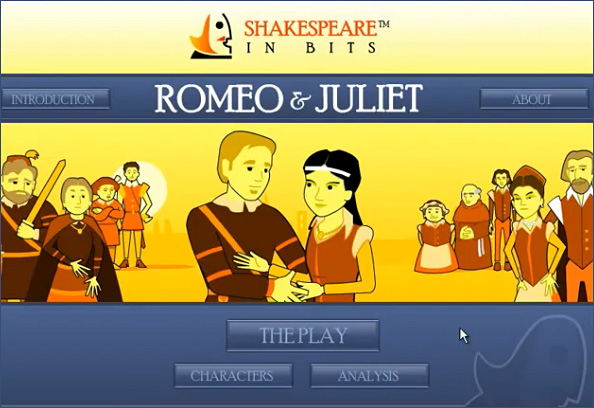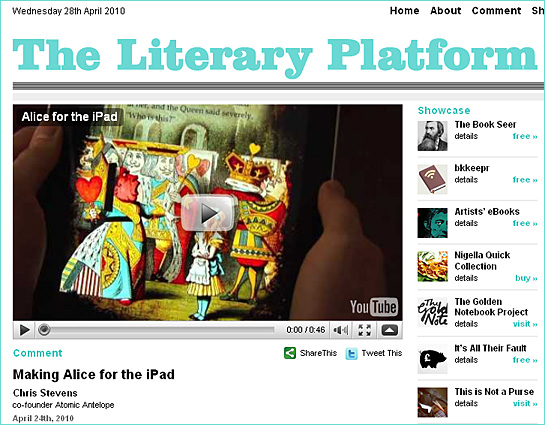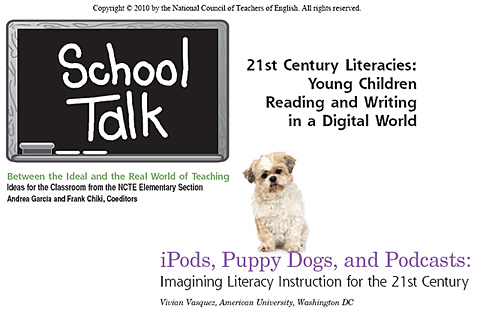Eight strategies for using blogs in a course — from nspired2

— from teleread.com by Paul Biba
The great thing about “recipe” books like the Moodle 1.9 English Teacher’s Cookbook is that they spark off ideas in you and motivate you to try them out with your own classes. I found that here from the very first chapter: suggested activities flow fast and freely from one page to the next, enthusing you with the desire to go off and personalise them. The author, Silvina P Hillar is an English teacher with a passion for technology and her technical reviewer, PHM Ben Reynolds is an award-winning fictionist and teacher of Writing. A lot of expertise has gone into tailoring the activities to the English classroom. You can read a breakdown of all the chapters here, but I’ll take them one at a time…
Some advice for authors on self-publishing and ebooks — from teleread.com
and
New vanity publishing? — from publishingguru.blogspot.com
It’s a pretty good system for everyone involved in the making of a best-seller. Efficiency, ease of promotion, a pre-determined outcome, and everyone gets paid, even though about half of those hardcovers will eventually be composted, too. If you can publish a best-seller, you’d be crazy to publish anything else.
If you are at the bottom end of the mid-list scale, you’d be crazy to give your book license away at current industry standards. Let’s examine the three publisher advantages in light of the modern digital/print-on-demand landscape.
It’s all Latin to me: Latin abbreviations in scholarly writing — APA Style blog by Chelsea Lee
Also:
You can download a PDF of the Latin abbreviations table here if you would like to use it as a handout for teaching or classroom purposes.
Ira Glass on the building blocks of storytelling — from Common Craft
Quote from Lee LeFever:
We’re big fans of Ira Glass and the This American Life radio show/podcast. We listen to every show on the podcast and there are few broadcast storytellers that I respect more. Via an older post on the Explainist blog, I found these videos of him describing the process of researching and crafting stories from back in 2006. He names two building blocks of storytelling and how they work together. Really great perspectives that you can hear in every story he tells.
===================================
WRITING IN (AND ABOUT) THE FUTURE
===================================
The journal-turned-magazine CREATIVE NONFICTION celebrated its
transformation by organizing a one-day symposium, held at the Writer’s
Center in Bethesda, Maryland, focused on how writing, reading, and
publishing may be transformed in the decade ahead.
On the program were two futurists: Jay Ogilvy, co-founder of the Global
Business Network, who described the usefulness of scenario thinking for
weighing both optimistic and pessimistic visions of the future, and Dan
Sarewitz, director of the Consortium for Science, Policy and Outcomes
at Arizona State University, who warned of the unexpected consequences
of human enhancement that many enthusiasts are hailing as a golden age
of prosperity, pointing out that the greatest example of that
enhancement is the soldier.
The bulk of the conference focused on how writers fit into this future,
a time when people may be reading fewer books but communicating with
one another and, yes, reading via a wider variety of platforms–e.g.,
blogs, Twitter, Facebook, and the multimedia digital Vook (video book)
described by Jack Sallay, the company’s vice president of marketing.
Writers of the future will bear more of the responsibility of reaching
their audiences, as publishers’ economic models become less supportive
of traditional functions like marketing and promotion, many of the
symposium participants argued. The good news is that there are more
innovative new ways of doing-it-yourself, like building a community of
supporters around an author’s blog.
As long as the written word is still valued (whether it is ultimately
read, viewed, or listened to by the audience), writing has a future.
DETAILS: CREATIVE NONFICTION, http://www.creativenonfiction.org
The Writer’s Center, http://www.writer.org
PHOTOS FROM THE CONFERENCE:
http://www.wfs.org/April-May2010/Update/photos.htm
Career readiness: Don’t expect too much from colleges — from educationnext.org by Mark Bauerlein
A few weeks ago, Hart Research Associates released a report entitled “Raising the Bar: Employers’ Views on College Learning in the Wake of the Economic Downturn.” The report listed the findings of a survey of 302 employers whose firms have 25+ employees, with at least one-fourth of new hires possessing a two-year or four-year college degree. It was commissioned by the Association of American Colleges & Universities, apparently to determine how well post-secondary school curricula match up with workplace demands.
One of the broadest indicators: “Only one in four employers thinks that two-year and four-year colleges are doing a good job in preparing students for the challenges of a global economy.”
Interestingly, employers didn’t endorse a training-oriented kind of preparation. They preferred “a blend of liberal and applied learning.” Indeed, they emphasized not only skills and knowledge tailored to a specific field, but also “a broad range of skills and knowledge.” (emphasis DSC)
Because of the focus on the “global economy,” on the actual conditions of the downturn and the “more complex” realities of our hyper-connected world, the report speaks of “active learning,” “real-world settings,” “cultural and ethnic diversity,” “the challenges of today’s global economy,” “ethical decision-making,” and “emerging educational practices.” These ideas and terms are common enough in education circles. (emphasis DSC)
From DSC:
I post this with hesitation, as I don’t see parents — or students who are funding their own educations these days — having the luxury to take such a viewpoint. At the price of $100,000+ for 4 years, can someone not expect a serious ROI that involves being able to (at least in some substantial part) “hit the ground running”?
On another note, I suppose Mark’s right to say that the earlier students learn how to write well the better (and he emphasizes the importance of the middle and high school years). However, that doesn’t seem to be happening in many cases. Hmmm….no easy answers here…as he mentions, learning how to write is a labor-intensive process.


















